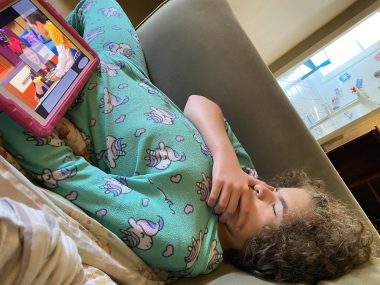Using Naps to Balance My Angel’s Busy Days

Napping is a great tool to balance out the hyperactivity and the extra energy that Angels seem to have. Even a short nap, often referred to as a power nap or a catnap, can make all the difference in improving behavior.
Upon first glance, taking naps may seem counterintuitive for a child who has sleep disturbances, a common symptom of Angelman syndrome. However, I’ve found the opposite to be true for our 12-year-old Angel, Juliana.
Sleeper by day and night
Like many Angels, Juliana may have difficulty sleeping at bedtime. Typical Angelman sleep problems may include trouble falling asleep, night walking, and shortened sleep time. Despite those challenges, Juliana is a good sleeper. A few years ago, when our family did a sleep study, we monitored Juliana’s sleep habits for a year. It validated that we had established a bedtime routine that helped her fall and stay asleep.
Of course, there are occasions when Juliana may not sleep well for a variety of reasons. She’s a light sleeper, so the slightest noise can wake her up. On nights when Juliana is up, I plan for her to have a nap the next day. Sleep is a commodity that is hard to replace when you lose it. However, a nap after a restless night helps Juliana a lot.
For a hyperactive Angel, having a napping routine is a good thing. When Juliana was younger, she and her sister, Jessa, followed a daily nap schedule. When she entered elementary school, the naps continued. As we adjusted to a new schedule, it became tougher to schedule a nap. Her teachers noticed the difference right away and commented on the difference in her behavior. Once, her teacher sweetly asked if I could work them back into our schedule.
A little snooze
It became difficult to pull off a nap every day, so I began alternating napping days. I also did this so that she wouldn’t have too much rest to keep her up at night. On nap days, I would sit in her room with her and quietly tiptoe out when she fell asleep. Sometimes, I would take a cue from Juliana and nap, too. I would simply set an alarm for both of us to get up after a short rest.
Nap days also meant that Juliana would go to bed an hour or so later than usual since she was more rested. Even with the nap, she would still fall off to sleep just fine. It took me some time to get the balance right, and eventually, her naps only lasted 35 to 45 minutes. Anything more and she would be bouncing around in her bed well into the night.
This school year, I’ve tapered her naps after school. But that doesn’t stop Juliana from taking a snooze when she needs it. Some days, I can tell when she needs a reset. On those occasions, I’ll put her in her nightclothes and have her lie down in her bed.

Exhausted from her school day, Juliana dozes off for a nap while watching her iPad. (Photo by Sabrina L. Johnson)
Just what the doctor ordered
This was the case a week ago before we started spring break. Juliana came home upset and couldn’t be consoled. Although she has been fussy and irritable, I could tell that this was something else. It took about 20 minutes for me to realize that she wouldn’t last until bedtime.
She was exhausted from a field trip at school. So with the blackout shades in her room tightly drawn, I let her sleep it out. When she got up she was better, but a few days later, we discovered she had an ear infection. We are clocking illness number four since December. But thankfully, a round of antibiotics has settled down the infection.
I love what naps can do both for the body and the spirit. Sometimes we just need a reset. Moreover, for Juliana, it serves as a means to calm her down and give her the energy to finish off the day with a smile.
Note: Angelman Syndrome News is strictly a news and information website about the disease. It does not provide medical advice, diagnosis, or treatment. This content is not intended to be a substitute for professional medical advice, diagnosis, or treatment. Always seek the advice of your physician or other qualified health provider with any questions you may have regarding a medical condition. Never disregard professional medical advice or delay in seeking it because of something you have read on this website. The opinions expressed in this column are not those of Angelman Syndrome News or its parent company, Bionews, and are intended to spark discussion about issues pertaining to Angelman syndrome.








Leave a comment
Fill in the required fields to post. Your email address will not be published.